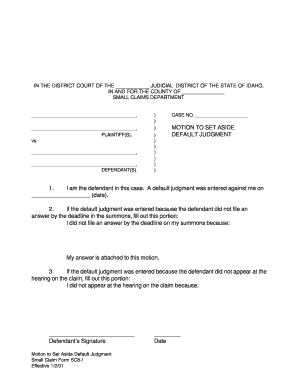
An affidavit which is void of supporting factual basis for the alleged excusable neglect will not constitute excusable neglect.

An unsworn assertion of excusable neglect will not suffice to meet this prong. The affidavit or sworn statement must prove a legal excuse exists for failing to respond to the complaint in a timely fashion.

Interpretation of Three-Prong Criteria (1) Excusable NeglectĮxcusable neglect is found “where inaction results from clerical or secretarial error, reasonable misunderstanding, a system gone awry or any other of the foibles to which human nature is heir.” To establish excusable neglect, the movant must file an affidavit or sworn statement explaining or justifying the mistake or inadvertence. The Second District Court of Appeal has observed a distinction between the two types of relief sought, “albeit of degree”, ruling that the court examines denial of a motion to set aside a default with more caution and holds to movant to a lesser standard than one requesting a final judgment be set aside. This type of analysis has been followed in this state since at least 1863 when the Supreme Court of Florida inquired into the reason for delay, fault, and defenses alleged by the defendant upon hearing a motion to have the default opened. The burden of establishing the presence of the three-prongs is upon the movant. The court must deny a Rule 1.540(b) motion if any one of the three elements is not established. The movant must demonstrate: (1) excusable neglect in failing to timely respond to the allegations of the complaint, (2) due diligence in seeking relief from a default or default judgment after discovery of same, and (3) a meritorious defense exists. The court will exercise its discretion upon hearing a Rule 1.540(b) motion to vacate default or a motion to set aside default judgment based upon a three-prong test analysis. Where a question exists as to a movant meeting the criteria for setting aside a default, “all reasonable doubts should be resolved in favor of setting aside the default.” The interpretations and rules governing setting aside defaults apply a principle of liberality to encourage causes of action be heard on their merits.
#Motion to set aside default judgment trial
Pursuant to Florida Rules of Civil Procedure 1.500(d), the trial court is vested with discretion to set aside a default. From now on simply cope with it from your apartment or at the place of work right from your smartphone or personal computer.In 1873, the Florida Legislature enacted a statute providing for the vacating of defaults upon “good cause shown” and “within sixty days from the time of entry of such default.” Though the statute was repealed in 1955, the Supreme Court of Florida assured the purpose was not to eliminate the procedure for vacating defaults.

#Motion to set aside default judgment download


 0 kommentar(er)
0 kommentar(er)
